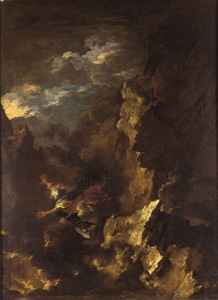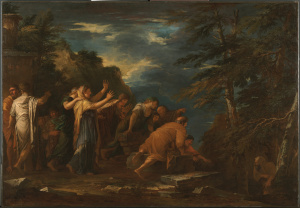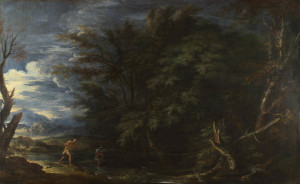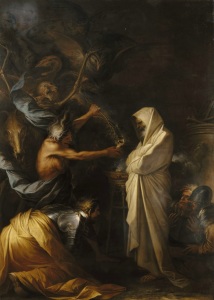CLASS: BONE DEEP GOTHIC
Curious what this is all about? Find out here!
By the 1660s, Rosa had achieved fame, respect, and plentiful commissions. However, he had not received them on his own terms. Feeling that he would be forever associated with small landscapes and denied the prestige that was his due, he resumed travel throughout Italy, painting the sort of ambitious work prescribed by the most respected critics of the day. These were stark, formal, historically precise, and much less spontaneous feeling that Rosa’s earlier works. Pythagoras coming out of the Cave might be considered to be a typical example.
While these works were favorably received, they did not fetch the prices for which Rosa had hoped, and it upset him that many of his etchings were not followed up with commissions for full paintings. He fell out with Queen Christina of Sweden over the cost of his paintings, and even some of Rosa’s favorite patrons were taken aback at his determination to fetch very high prices and his obstinate avoidance of smaller works. Patrons felt, in general, that he had little gift for this style of human figure and that the details of his classical and historical paintings were awkward and clunky. Eventually returning to the landscapes he had painted with such deftness in the 1640s and 50s, Rosa now infused them with an air of obscurity and mystery. New patrons and Milan and Rome responded favorably to this work and paid Rosa generously.
As the decade wore on, Rosa’s health became ever more unstable and took an increasing toll on his painting. Detail work troubled him, modeling was difficult, and he sometimes went many months without painting. He reconciled with Queen Christina and moved frequently within her circle of artists and scientists. His late works articulate a sort of unsettling mysticism; the uncertainty of humanity in the face of the infinite, which was also to provide inspiration to later theorists of the sublime. In Saul and the Witch of Endor a hell of chaos is unleashed against the stone-faced, pillar-like prophet. In The Death of Empedocles (picture at top) a much more literal hell of fire illuminates the philosopher from below at the moment that he flings himself into the volcano.
Rosa continued to enjoy a favorable reputation until the very end, but he was depressed by his failing health and inability to paint. His belief that he had failed to achieve an enduring fame during his lifetime tormented him, and he was overcome in his last few years with a bitterness and pessimism. In February 1673 he enjoyed one last visit from his lifelong friend Ricciardi. He married Lucrezia on his deathbed. Two weeks later, after haranguing a priest for calling for greater fortitude and admonishing his friends against a desire for immortality, Salvator Rosa died.
Sources:
Helen Langdon, Salvator Rosa




